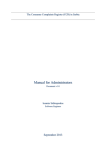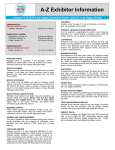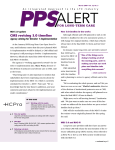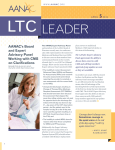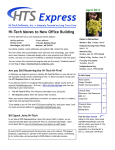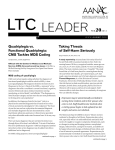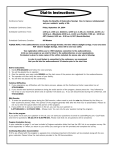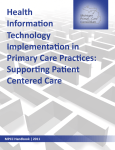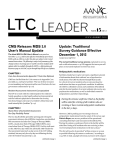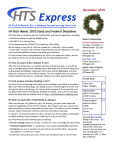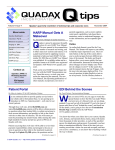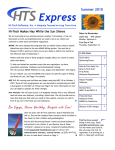Download PPS Alert for Long
Transcript
An Integrated Approach to the LTC Industry P5 PPS Alert for Long-Term Care Volume 16 Issue No. 10 Redesigned Medicare Summary Notices add to focus on fraud and abuse Learn more about the changes and how they aim to help beneficiaries identify fraudulent billing practices. P7 GAO report reveals flaws in manual medical review process A recent report shows that Medicare Administrative Contractors lacked guidance, but fails to include the provider’s and beneficiary’s perspective. P9 HHS proposes updates to LTC Ombudsman program The changes aim to strengthen the program and consistency between states. P11 MDS professor P12 PPS Q&A October 2013 CMS issues final payment changes for fiscal year 2014 The final regulation is almost identical to the proposed rate changes, with a 1.3% overall increase and an addition to the MDS If you hate surprises, then you were probably pleased with the final rule for the prospective payment system and consolidated billing for SNFs for fiscal year (FY) 2014. Released by CMS on August 1, the final rule is almost identical to the proposed changes that were released in May. Although the proposed rate increase was originally set at 1.4%, the final rule rounded out just shy at 1.3% (2.3% update factor, minus 0.5% market basket forecast error or adjustment, minus 0.5% multifactor productivity [MFP] adjustment as part of the Affordable Care Act). However, that 1% cut translates to a $30 million overall decrease. “There are usually a lot of changes from the proposed rule to the final rule, but this time it was almost exactly the same,” says Diane L. Brown, BA, CPRA, director of postacute education at HCPro, Inc., in Danvers, Mass. In fact, given the fact that the sequestration took a 2% cut out of the Medicare budget back in April, many view this payment update as a neutral change. Think you’re an MDS expert? Test your knowledge with our quiz. This Q&A explains the role of a unscheduled assessment. Trendspotting $1.7 billion The amount of mandatory funding the Affordable Care Act (ACA) provided for both 2010 and 2011, including discretionary funding of $311 million for 2010 and $561 million for 2011, all of which went toward fraud enforcement efforts in a variety of federal programs, including CMS and the Office of Inspector General. $14.9 billion The amount that the Obama administration (over the past four years) has recovered in healthcare fraud judgments, settlements, and administrative impositions. 14,663 The number of providers and suppliers, since the passage of the ACA in March 2011, that have had their ability to bill within the Medicare program revoked by CMS. Felony convictions, wrong operational addresses, or failure to comply with CMS regulations were among the primary reasons for dismissals. Source: CMS. PPS Alert for Long-Term Care October 2013 This document contains privileged, copyrighted information. If you have not purchased it or are not otherwise entitled to it by agreement with HCPro, any use, disclosure, forwarding, copying, or other communication of the contents is prohibited without permission. editorial advisory board Assoc. Editorial Director Todd Hutlock [email protected] Contributing Editor Evan Sweeney Editor Melissa D’Amico [email protected] Diane L. Brown, BA, CPRA Regulatory Specialist and Boot Camp Instructor HCPro, Inc. Danvers, Mass. Mary C. Malone, JD Healthcare Attorney, Director Hancock, Daniel, Johnson & Nagle, PC Richmond, Va. Sandra Fitzler Senior Director of Clinical Services American Health Care Association Washington, D.C. Maureen McCarthy, RN, BS, CPRA Vice President of Clinical Reimbursement National Healthcare Associates Goshen, Conn. Bonnie G. Foster, RN, BSN, MEd Long-Term Care Consultant Columbia, S.C. Cindy Frakes Owner Winter Meadow Homes, Inc. Topeka, Kan. Julia Hopp, MS, RN, NEA-BC Executive Vice President of Reimbursement Paramount Health Care Company Garden Ridge, Texas Frosini Rubertino, RN, CPRA, CDONA/LTC Executive Director Training in Motion, LLC Bella Vista, Ark. Holly F. Sox, RN, BSN, RAC-CT MDS Coordinator Presbyterian Communities of South Carolina Lexington, S.C. Steven B. Littlehale, MS, GCNS-BC Executive Vice President, Healthcare Chief Clinical Officer PointRight, Inc. Lexington, Mass. PPS Alert for Long-Term Care (ISSN: 1521-4990 [print]; 19377428 [online]) is published monthly by HCPro, Inc., 75 Sylvan St., Suite A-101, Danvers, MA 01923. Subscription rate: $239/year. • PPS Alert for Long-Term Care, P.O. Box 3049, Peabody, MA 01961-3049. • Copyright © 2013 HCPro, Inc. • All rights reserved. Printed in the USA. Except where specifically encouraged, no part of this publication may be reproduced, in any form or by any means, without prior written consent of HCPro, Inc., or the Copyright Clearance Center at 978-750-8400. Please notify us immediately if you have received an unauthorized copy. • For editorial comments or questions, call 781-639-1872 or fax 781-639-7857. For renewal or subscription information, call customer service at 800-650-6787, fax 800-639-8511, or email [email protected]. • Visit our website at www.hcpro.com. • Occasionally, we make our subscriber list available to selected companies/vendors. If you do not wish to be included on this mailing list, please write to the marketing department at the address above. • Opinions expressed are not necessarily those of PPSA. Mention of products and services does not constitute endorsement. Advice given is general, and readers should consult professional counsel for specific legal, ethical, or clinical questions. 2 hcpro.com Quick Hits Online from the field Visit us in Chicago: HCPro seminar coming in November “Beneficiaries are a very important line of defense. Particularly in situations where their identity has been stolen, [the Medicare Summary Notice] may be the only way it’s recovered. It’s about taking more time to educate them on what is truly fraud and abuse, how to report it, and making that notice easy to understand.” Join us in Chicago for the only conference that covers long-term care quality improvement while focusing on reducing financial risk. At this exciting conference, HCPro’s regulatory expert Diane L. Brown, BA, CPRA, will show you how to implement an action plan to effect real change. Identify methods to improve resident care by avoiding adverse events and determine an action plan for reducing rehospitalizations. Resident quality of care is always at the forefront of CMS initiatives as it focuses on the link between quality and appropriate reimbursement. For SNFs, identifying financial risk factors has become more complex, so they must find ways to improve quality of care and reduce rehospitalizations. Seminar participants will be able to: • Identify common financial and clinical risks within their facility with a focus on resident care • Recognize the signs of an adverse event and the steps to take to stop future adverse events • Implement an action plan within their facility to ensure quality resident care To learn more about this seminar, visit www. hcmarketplace.com/ev-11169/MaximizeQuality-While-Minimizing-Financial-RiskImplementing-a-LongTerm-Care.html. Follow Us Follow and chat with us about all things healthcare compliance, management, and reimbursement. @HCPro_Inc Questions? Comments? Ideas? Contact Editor Melissa D’Amico at mdamico@ hcpro.com or 781-639-1872, Ext. 3505. Wayne van Halem, CFE, AHFI stay connected PPSA in Your Inbox Sign up for any of our 17 email newsletters, covering a variety of healthcare compliance, management, and reimbursement topics, at www.hcmarketplace.com. Don’t miss your next issue If it’s been more than six months since you purchased or renewed your subscription to PPS Alert for Long-Term Care, be sure to check your envelope for your renewal notice or call customer service at 800-650-6787. Renew your subscription early to lock in the current price. Relocating? Taking a new job? If you’re relocating or taking a new job and would like to continue receiving PPS Alert for LongTerm Care, you are eligible for a free trial subscription. Contact customer service with your moving information at 800-650-6787. At the time of your call, please share with us the name of your replacement. © 2013 HCPro, Inc. For permission to reproduce part or all of this newsletter for external distribution or use in educational packets, contact the Copyright Clearance Center at copyright.com or 978-750-8400. October 2013 • • • • Some of the other changes included in the final rule: Monitoring the impact of policy changes from the FY 2012, including: –– Recalibration of FY 2011 SNF parity adjustment –– Allocation of group therapy time across group (allows only 25% to be captured for each of four patients) –– Implementation of MDS 3.0 changes (includes the Change of Therapy [COT] OMRA assessment, which intended to more accurately capture therapy services) Revising and rebasing the SNF market basket index from FY 2004 to FY 2010, which includes additional components and details to cost categories. Adding a new MDS item (00420, Distinct Calendar Days of Therapy), which aligns the MDS and RUG process to ensure high-level therapy is provided five days per week. Previously, the payment grouper would add days of therapy regardless of whether those services were provided on distinct days. CMS included a PPS AIDS payment add-on. Currently, SNFs that care for residents with AIDS or active HIV add an ICD-9 code 042 to the UB-04 form, which activates the 128% add-on. After the transition to ICD-10, CMS will link the add-on to code B20. Although there are many significant changes to the final rule, the regulation does give an inside peek into the process that CMS uses regarding payment updates, says Maureen McCarthy, vice president of clinical reimbursement at National HealthCare Associates in Lynbrook, N.Y., and president at Celtic Consulting, LLC, in Goshen, Conn. “I like to know what makes up the market basket,” she says. “Some coordinators and nurses really don’t necessarily understand what the market basket is, and I really like to get in to the details of that. You’re looking at wages and salary, employee benefits, contract labor, pharmaceuticals, liability insurance from a cost report, but they weigh it all a little bit differently.” Although it’s likely the final rule will cause a lot of commotion among SNFs, providers should begin PPS Alert for Long-Term Care reviewing the final rule and at least have some discussions about preparing for the effective date of October 1. MDS addition The addition of the MDS code to track distinct therapy days should not be a huge adjustment for SNFs since it doesn’t change any of the therapy requirements that already exist; it simply streamlines the MDS form to capture more specific data. For example, if a resident receives physical therapy three times a week and occupational therapy two times a week, MDS software will categorize it as five distinct therapy days, even if that therapy was coordinated over the course of three days. CMS clarifies that low rehab is classified by three distinct therapy days. With the addition of the MDS code, software programs will be able to track distinct therapy days without inadvertently placing residents into a higher RUG category. The ruling will probably have the biggest impact on residents categorized under rehab medium, which requires five distinct therapy days, says Cheryl Field, vice president of healthcare at PointRight, Inc., in Lexington, Mass. Since the proposed rule, PointRight reviewed its database and found that the rehab medium category makes up about 10% of its patients. “The take-home message to providers really hasn’t changed,” she says. “It just requires for that lower intensity group that there is conversation and planning around what days of the week treatment will be provided if you’re not providing five-day-a-week treatment.” McCarthy says she is concerned about residents that don’t meet the qualifications for a short stay, but still need rehab. This could also affect residents that have just been admitted and are just gearing up for therapy, or those that are gearing down because they are being discharged. “I’m concerned that those residents will potentially fall into the lower 14 nursing categories where some of the MACs out there do an automatic ADR just because they fell into the lower level category,” she says. “They may be appropriately working this patient up to a certain level, but didn’t have enough days where therapy was provided, so they ended up falling into that © 2013 HCPro, Inc. For permission to reproduce part or all of this newsletter for external distribution or use in educational packets, contact the Copyright Clearance Center at copyright.com or 978-750-8400. hcpro.com 3 PPS Alert for Long-Term Care October 2013 lower nursing category. I’m worried about provider liability in those circumstances.” McCarthy also notes that CMS provided a clarification regarding “Medicare holidays,” indicating that it’s a misconception that CMS provides specific breaks in therapy for a prescribed list of national holidays. “You can have up to a two-day miss for therapy, but the holiday would be included in that twoday miss,” she says. For example, Labor Day would not count as a break in coverage. SNFs and therapists need to coordinate therapy time either on Saturday or Monday of that three-day weekend in order to meet the requirements for distinct therapy days. A number of commenters also brought up the issue of non-therapy ancillaries (NTA), which called for CMS to expedite the research necessary for a new method to pay for NTAs cared for by SNF providers. CMS responded without any specific changes, but that it was looking forward to working with providers and stakeholders in the future. However, Field doesn’t expect any upcoming changes. “I think the reality is with the Accountable Care Act and the movement towards managed care and bundles and the profit-sharing model, there will be no reason to talk about non-ancillary therapy,” she says. “It’ll be part of the bundle. I think they are going to wait for the bundles to show their validity and MDS professor answer key Below are the answers to the MDS professor on p. 11: 1. d. MDS data is not used to determine Medicare Part B reimbursement. 2. a. This is usually the correct choice when a resident goes out to the hospital and the Admission Assessment has already been completed. A resident’s bedhold status is not taken into consideration when completing a discharge tracking form. 3. d. All of the above. 4. d. All of the above. 5. c. Five to seven. 6. b. 15. 4 hcpro.com if it’s a more efficient and effective way of providing care, then they won’t have to talk about this nonancillary component.” Evaluating the 2012 “double hit” In the final rule, CMS also evaluated the potential “double hit” from the FY 2011 SNF parity adjustment and policy changes that included the COT OMRA. At least one commenter asked CMS to reevaluate the negative impacts of COT OMRA as “unnecessary and inflexible.” CMS responded that COT OMRA makes up just 11% of all assessments completed for SNF residents, which it doesn’t believe makes up a significant burden for providers. In fact, CMS argued, “the COT OMRA has helped ensure greater accuracy of SNF payments and ensure that providers are appropriately reimbursed for the level of care delivered to their residents.” McCarthy argues that although 11% may seem low, it may represent a significant workload for small providers. “Those are 11% more assessments than we did in the past,” she says. “It’s not a large number, but it’s a large addition for an MDS coordinator who is the only one in the building and now has to increase her productivity by 11%. They are taking into consideration the numbers of MDSs, but when you also add in discharge MDS and change of therapy that’s a significant increase in workload for the average MDS coordinator.” How to prepare Fortunately, SNFs probably won’t need to change much in their own system to prepare for the updated payment system. Providers should ensure they adjust their software to include the additional MDS code for distinct therapy days, but they shouldn’t need to change much in terms of policies or procedures. However, SNFs should discuss and review the updates through their compliance and ethics program and at least have a conversation about the details of the final rule, particularly regarding distinct therapy days, Field says. “They could simply add an agenda item to look at the rehab mediums or the unique days of the week that therapy is provided,” she says. “They could certainly add that to their compliance checks and their month end checks that are supporting their compliance initiatives. It’s just one more thing they can start monitoring within themselves.” H © 2013 HCPro, Inc. For permission to reproduce part or all of this newsletter for external distribution or use in educational packets, contact the Copyright Clearance Center at copyright.com or 978-750-8400. October 2013 PPS Alert for Long-Term Care Redesigned Medicare Summary Notices add to a growing focus on fraud and abuse Simplified notices aim to help beneficiaries identify fraudulent billing as the crackdown on Medicare fraud and false claims continues If 2013 has shown us anything, it’s that the government is dead serious about reducing Medicare fraud, and they’ve decided to attack the issue from all angles. In June, CMS announced that it would be rolling out a new, redesigned Medical Summary Notice (MSN), an additional effort by the Obama administration to eliminate fraud, waste, and abuse. The redesign will simplify the notice, making it easier for beneficiaries to interpret their Medicare benefits and possibly uncover instances of fraud and abuse by providers. “The new Medicare Summary Notice gives seniors and people with disabilities accurate information on the services they receive in a simpler, clearer way,” CMS Administrator Marilyn Tavenner said in a press release. “It’s an important tool for staying informed on benefits, and for spotting potential Medicare fraud by making the claims history easier to review.” This is a welcomed and long-overdue change for beneficiaries, says Wayne van Halem, CFE, AHFI, president of The van Halem Group, LLC, in Atlanta. For years, health experts and beneficiaries have been asking for changes that would simplify MSNs. These notices should add another layer of fraud detection, but more importantly, it will help Medicare beneficiaries better understand their coverage. Even those wellversed in Medicare language and regulation found the previous notices difficult to interpret. “I don’t know if you’ve seen the notice, but they are fairly complex and difficult to understand,” he says. “Most patients get them, and even me, as someone who has worked with Medicare and deals with it on a regular basis, I find it difficult to read at times. Certainly someone with no experience in this realm would see this and wouldn’t know what to do with it.” The simpler format will also provide an additional avenue in which the government can identify or investigate instances of fraud. “Beneficiaries are a very important line of defense,” van Halem says. “Particularly in situations where their identity has been stolen, that notice may be the only way it’s recovered. It’s about taking more time to educate them on what is truly fraud and abuse, how to report it, and making that notice easy to understand. I think it will result in more solid information coming from beneficiaries that could help uncover fraud; I just don’t know what took them so long to do this.” While the changes are certainly useful in helping beneficiaries better understand their bill, they could also prompt more frivolous and unnecessary fraud investigations, says George Breen, a partner with Epstein Becker Green in Washington, D.C. “It has the potential to encourage over-reporting, putting providers in the situation where they face the potential for audits or investigations without a legitimate factual basis and to incur expenses that are totally unnecessary,” he says. Fraud detection over the last year The format change to the MSN is just the most recent tactic the government has utilized to uncover instances of fraud and abuse. Over the last year, various regulation changes and calls for increased oversight have put fraud and abuse at the forefront. Below is a list of issues to which SNFs need to pay particular attention. • The Affordable Care Act (ACA): Although most of the discussions about the ACA have revolved around beneficiary coverage and the impact it will have on employers and taxpayers, the ACA includes very aggressive spending on identifying Medicare fraud: –– The ACA provided mandatory funding of $1.7 billion for both fiscal year 2010 and 2011, including discretionary funding of $311 million for FY 2010 and $561 million for FY 2011, all of which went toward fraud enforcement efforts in a variety of federal programs, including CMS and the Office of Inspector General. –– Over the past four years, the Obama administration has recovered over $14.9 billion in healthcare fraud judgments, settlements, and © 2013 HCPro, Inc. For permission to reproduce part or all of this newsletter for external distribution or use in educational packets, contact the Copyright Clearance Center at copyright.com or 978-750-8400. hcpro.com 5 PPS Alert for Long-Term Care October 2013 dministrative impositions, according to CMS. a –– Since the passage of the ACA in March 2011, CMS has revoked the ability of 14,663 providers and suppliers to bill within the Medicare program. Felony convictions, wrong operational address, or failure to comply with CMS regulations were among the primary reasons for their dismissal from the program. –– After putting in screening and review requirements set forth by ACA, the number of revocations has quadrupled. The ACA has also allowed CMS to devote more funds toward proactive data analysis to track and act upon potential fraud and abuse. “When there is that kind of money behind it, it stands to reason that their intent is to increase the amount of recoveries,” says George Bodenger, a partner at Saul Ewing, LLP, in Philadelphia and chair of the firm’s Health Practice Group. The ACA also included an important procedural change in the way CMS recovers Medicare payments. Rather than utilizing a “pay and chase” model in which CMS would attempt to recover funds after it had already made payments to a provider, the ACA adjusted the model to catch potential fraud before payments are released. “Really what they are trying to do is focus more on the front end and do more provider screening and more scrutiny up front so they aren’t letting folks get into the program that have a history,” van Halem says. “That’s where we’re seeing more revocation and more activity because they have the funding to do it. You’re seeing audits, but then they are also implementing predictive modeling.” • OIG guidelines for state false claims acts: In March, following a review of 28 different state laws, the OIG released its “Updated OIG Guidelines for Evaluating State False Claims Acts.” The guidelines incentivized states to restructure their false claims act to meet OIG’s requirements, in exchange for an additional 10% on any amounts recovered. According to OIG, state laws must meet the following requirements in order to receive the additional recovery: –– Establish liability to the state for false or fraudulent claims, as described in the federal False Claims Act (FCA), with respect to Medicaid spending –– Contain provisions that are at least as effective in rewarding and facilitating qui tam actions for 6 hcpro.com false or fraudulent claims as those described in the FCA –– Contain a requirement for filing an action under seal for 60 days with review by the state attorney general –– Contain a civil penalty that is not less than the amount of the civil penalty authorized under the FCA Given the financial pressure that most states are facing, this is an easy opportunity to provide some reprieve to their budgetary woes. “You have a situation where states are faced with more budgetary pressure to deal with expanded Medicaid roles and they will have more incentive to pursue healthcare providers,” says Breen. “This clearly impacts the long-term care industry, which is heavily involved with Medicaid patients. You can expect that states will have a bigger incentive to pursue actions against providers because it’s clearly to their financial benefit.” • Increased whistleblower incentives: In April, CMS released a proposed rule that would significantly increase the rewards for whistleblowers that provide information that leads to a recovery of funds from providers that have engaged in fraud and abuse. The proposed changes include: –– Increasing the potential reward amount from 10% to 15% of the final amount collected for information that leads to a recovery of Medicare funds –– Increasing the reward cap from $1,000 to $9.9 million (a maximum of 15% of the first $66 million recovered) With the increased reward, CMS hopes to further incentivize whistleblowers to step forward and report fraud and abuse to the government. Since 1998, CMS has recovered approximately $3.5 million, but paid out just $16,000 for 18 rewards. CMS proposed rule changes are modeled after the IRS whistleblower program, which has seen significant recoveries following changes to its whistleblower reward program. At the same time, providers should be thinking about their internal reporting and auditing systems, says Margaret Surowka Rossi, council at Hiscock and Barclay in Albany, N.Y. “This not only incentivizes people to make these complaints, but it also should incentivize the providers to make sure they are focusing on regulating compliance and really doing a lot of the internal auditing and internal vigilance that is required,” Rossi says. H © 2013 HCPro, Inc. For permission to reproduce part or all of this newsletter for external distribution or use in educational packets, contact the Copyright Clearance Center at copyright.com or 978-750-8400. October 2013 PPS Alert for Long-Term Care GAO report reveals flaws in manual medical review process The July report shows that Medicare Administrative Contractors lacked guidance, but fails to include perspective from providers and beneficiaries During the final three months of 2012, in response to the growing concern regarding costs for outpatient therapy, CMS implemented two types of manual medical reviews (MMR). These MMRs reviewed preapproval requests and reviews of claims submitted without preapproval for all outpatient therapy services that were above $3,700. The MMR requirement caused a stir within the therapy and long-term care industry and CMS put considerable resources toward educating providers on the process, hosting four open door forums between March 2012 and October 2012, when the program began. CMS cited statistics on the previous year’s spending, including the $5.7 billion that Medicare spent on outpatient therapy services in 2011 for 48 million beneficiaries. In June 2013, the Government Accountability Office (GAO) released a report on the “Implementation of the 2012 Manual Medical Review Process.” The report showed a number of flaws within the system, particularly concerning the Medicare Administrative Contractors (MAC) that were tasked with conducting the reviews. The GAO reviewed relevant statutes and CMS policies and guidance, and conducted interviews with officials from three MACs that accounted for almost 50% of the MMR workload. CMS estimates that MACs affirmed roughly two-thirds of the 110,000 preapproval requests and about one-third of the 57,000 claims submitted without preapproval, but the final outcome of the MMRs remains uncertain. Specifically, the GAO found a number of problems regarding how the MMRs should be processed. CMS did not issue complete guidance on how to process preapproval requests before the implementation date and MACs were unable to fully automate their systems for tracking requests within the required 10 business day time frame. Requests that were not reviewed within 10 days were supposed to be automatically approved. Additionally, MACs struggled to implement reviews of preapproval requests because CMS continued to issue new guidance on how to manage those requests after the MMR process started. Because of the lack of guidance, each MAC handled the process in a different way. Although it was not addressed specifically in the report, the incongruity with each MAC’s process had a trickle-down effect that impacted the beneficiaries as well, says Nancy Beckley, MS, MBA, CHC, president of Nancy Beckley and Associates in Milwaukee. “This was an incredibly disruptive process,” Beckley says. “It started with a tremendous effort to notify every beneficiary about what was going on and at the same time they were conducting four different open door forums and then relying on each MAC to roll out the training and the data collection instrument and rules for submission.” Ultimately—from the perspective of the MACs, the providers, and the beneficiaries—there was a lot of confusion and very little uniformed guidance, which led to an imperfect process. In some cases, facilities that submitted post-payment MMRs in December still haven’t received a response, Beckley says. “No one really understood or had a grip on what was going on,” she says. “The MACs provided instructions, but if you compared each of them you would say how come there is one law and multiple different ways of providing this information.” Two missing pieces Although the report did highlight some of the major flaws with the MMR process, Beckley argues that the GAO left out the perspective of two important characters: providers and beneficiaries. “I don’t think the GAO report gives Congress the whole picture of how this process works nor does it represent the time and effort by the providers as well as the concern of beneficiaries,” Beckley says. From the provider’s perspective, the process was not only cumbersome, but expensive. Many providers designated money to gather data and submit requests, © 2013 HCPro, Inc. For permission to reproduce part or all of this newsletter for external distribution or use in educational packets, contact the Copyright Clearance Center at copyright.com or 978-750-8400. hcpro.com 7 PPS Alert for Long-Term Care October 2013 Beckley says. The larger providers often had to hire a full-time employee to assist with the workload. However, the report does at least encapsulate the confusion with the entire MMR process that ultimately left providers guessing, says Kate Brewer, PT, MBA, GCS, RAC-CT, president of Greenfield Rehabilitation Agency, Inc., in Milwaukee. “Providers were left to a trial and error method in many cases,” Brewer says. “From a provider standpoint, we spent countless man-hours trying to figure out the process and comply when they just used this process for three months and then discontinued it. It was even more confusing in early 2013 trying to figure out what to do—many providers were trying to continue the 2012 process because no one was giving guidance.” Part of the problem was that even though CMS asked the MACs to allow CD or electronic documentation, most only accepted fax or mailed submissions. Beneficiary documentation often exceeded 200 pages, which was a tremendous burden for facilities that needed to print or fax records. “Even with that methodology, the MACs were claiming they weren’t getting faxes or printed records and providers were saying they had fax receipts or had spent FedEx® money,” Beckley says. From the beneficiary’s perspective, the MMR process was a tremendous disruption to therapy. In the report, CMS told the GAO that the purpose of the preapproval process was to protect beneficiaries from being liable for payment of non-affirmed services by giving the provider and beneficiary guidance as to whether Medicare would pay for the requested services. However, in some cases, beneficiaries declined to continue coverage because of the potential financial burden of being denied therapy above the cap. “My frame of reference is always family members I know that are on Medicare,” Beckley says. “I like to put a human side to this, and there is clearly a human side missing in the report. This was about the Medicare beneficiaries, yet the GAO made it about the MACs.” Emphasizing good documentation There are two things that providers can take away from the GAO report: First, providers can expect continued scrutiny as they are asked to prove the medical necessity 8 hcpro.com of therapy services. Second, therapy documentation is more important than ever to provide that proof. It helps to look at the GAO report in the context of other reports that have come out regarding Medicare in the last year, says Beckley. In addition to the GAO report, Beckley continuously references the following: • Office of Inspector General (OIG) report on Spectrum Rehabilitation, LLC: This report released by the OIG in June estimates that Spectrum improperly received at least $3.1 million for outpatient occupational and physical therapy services that didn’t comply with Medicare requirements. Of the 100 claims that OIG randomly sampled, 83 were billed improperly and 44 contained more than one deficiency. • Chapter 9 from the MedPAC Report: The MedPAC Report released in June included a chapter entitled “Improving Medicare’s payment system for outpatient therapy services.” In it, MedPAC outlines recommendations including reducing the therapy cap for physical therapy and speech-language pathology services combined and the separate cap for occupational therapy to $1,270. The report also recommends collecting functional status information on therapy services using a streamlined, standardized assessment tool in order to classify patients across all therapy types. This tool would provide support for development of an episode-based or global payment system. “This is the [therapy] environment; it’s not just about one report,” Beckley says. “The big takeaway is the best thing that therapists can do on behalf of the therapy industry and on behalf of the beneficiaries is to really learn how to write good documentation. I think that’s so critical and I think it’s also sorely lacking.” A common issue, Beckley adds, is that therapists can easily verbally explain everything that is going on with the patient, but their documentation is sparse. Therapists also need to hold their ground when they feel a patient no longer needs more therapy. “They need to really, truly understand when it’s no longer medically necessary for the patient to continue,” Beckley says. “It’s okay take up that position with the family and the physician. Many therapists feel bad or back down when the physician provides another order or the family says ‘please do more therapy.’ ” © 2013 HCPro, Inc. For permission to reproduce part or all of this newsletter for external distribution or use in educational packets, contact the Copyright Clearance Center at copyright.com or 978-750-8400. October 2013 Brewer recommends setting up an internal process—in addition to routine chart auditing—to track beneficiaries that are getting close to the cap and review the documentation to ensure it is fully supporting the services provided. “We set up our own internal levels of review to ensure documentation is defensible and services continuing beyond the threshold, which are guaranteed to be reviewed, will prove to be payable,” she says. Particularly when it comes to documentation, therapists and providers can also work with their MACs to get PPS Alert for Long-Term Care more education and a better understanding as to what appropriate documentation should look like. “They can ask for education and ask for training, they can seek to get further information, and if the training is not sufficient or not in-depth enough, or simply is just quotes from Medicare manuals, they have a recourse through the provider outreach and education councils of each MAC to say we need more,” Beckley says. “The therapy industry needs to move forward and really demand, on behalf of the beneficiaries, a clear understanding of what needs to be in the documentation.” H HHS proposes updates to LTC Ombudsman program Proposed changes aim to strengthen the program and offer more consistency from state to state On June 14, the Administration on Aging and the Administration of Community Living (ACL), both within the U.S. Department of Health and Human Services (HHS), announced that it had posted a Notice of Proposed Rule Making in order to strengthen the Long-Term Care Ombudsman (LTCO) program across the country. The changes are designed to clarify how each state implements its program in order to establish more consistency regarding the duties and responsibilities of the LTCO. The LTCO in each state is a resource for LTC residents and serves as an advocate during instances of abuse, neglect, and financial exploitation. The LTCO often works as a middleman between the LTC facility and the resident in order to help fairly resolve disputes or complaints. Elder abuse is expected to rise with the growing populating of elders, according to an ACL press release. Additionally, elderly victims of even modest abuse have 300% higher morbidity and mortality rates compared to non-abused residents, the ACL says. The proposed rule addresses the following issues: • Responsibilities of the State Ombudsman, State Agency on Aging, and Representatives of the Office of the State LTCO related to the program operations • Consistent approaches to resolving complaints on behalf of residents • Appropriate role of ombudsmen in resolving abuse complaints • Conflicts of interest—processes for identifying and remedying conflicts so that residents have access to effective, credible ombudsman services “HHS is committed to strengthening the ability of long-term care ombudsman staff and volunteers to be effective problem-solvers for older adults and people with disabilities who live in our nation’s longterm care facilities,” Assistant Secretary for Aging Kathy Greenlee said in a press release. “Long-term care ombudsman programs are often a lifeline for victims of abuse, and it is fitting to present these proposed changes as we recognize World Elder Abuse Awareness Day.” In one sense, this is a welcomed change throughout the LTC community, primarily because the responsibilities of LTCOs have varied so drastically from state to state and the responsibilities of the ombudsmen were often vague or unclear. On the other hand, there is some concern that new regulations will pressure ombudsmen to unnecessarily report facilities rather than working with them to resolve disputes, says Mary Malone, © 2013 HCPro, Inc. For permission to reproduce part or all of this newsletter for external distribution or use in educational packets, contact the Copyright Clearance Center at copyright.com or 978-750-8400. hcpro.com 9 PPS Alert for Long-Term Care October 2013 a healthcare attorney and director of Hancock, Daniel, Johnson & Nagle, PC in Richmond, Va. “We’re not surprised at the timing because this has been out there as a proposed rule since 1994,” Malone says. “It seems like the reason it has come forward now for comment and finalizing is to address the need for consistency and to ensure that across the country there are some of the same types of programs that are intended to protect the interests of the elderly.” The comment deadline to the proposed rule was August 19, 2013. In the interim, facilities should familiarize themselves with the proposed changes in order to gain a better understanding of how the LTCO will operate moving forward. Redefining responsibilities The main impetus behind the proposed changes is the need for consistency within the LTCO program. For that reason, some states may see some significant changes to their program should the proposed rules be finalized. But these changes may actually improve the way LTCOs and LTC facilities interact with one another, says Bonnie Foster, RN, BSN, MEd, owner and president of Foster Consulting, Inc., in Columbia, S.C. In some cases, LTCOs may believe they have more power than they actually do. “Ombudsman is supposed to be the liaison between the resident and everyone else, but I never personally thought that their role helped very much,” she says. However the proposed updates also bring some potential concerns. Typically new regulations are accompanied by a spike in enforcement, says Jeannie Adams, attorney on the administrative law team and director of the Richmond, Va. office of Hancock, Daniel, Johnson & Nagle, PC. Subsequently, facilities may experience LTCOs that are more aggressive than they may have been in the past. “One thing that LTC facilities need to be prepared to see is an ombudsman coming into their facility with greater frequency to investigate complaints and in the process, accessing resident records,” Adams says. There is also some concern that the changes will allow ombudsmen to unnecessarily persuade residents to file complaints. LTC facilities are already one of the most regulated industries in the country, and these changes could pile on an additional strain. 10 hcpro.com “From where we stand, we certainly support the protections of the elderly, but it’s putting the facilities that are trying to care for them under greater and greater strain,” Malone says. “We just hope these regulations aren’t going to send a signal to the ombudsman, who in the past in their role as advocates for the resident worked hard to resolve issues with the residents rather than just reporting them.” Improving resident communication One way that LTC providers can proactively address the proposed changes to the LTCO program is by focusing on Quality Assessment and Performance Improvement (QAPI) implementation and improving communication with residents and their families. A comprehensive QAPI program will identify areas in where residents are dissatisfied with their care, Foster says. “I think what’s really going to have to improve, which I have always said, is documentation,” she says. “It’s not just documenting, but managers need to be rounding and keeping a running tab of what residents say and are they concerned about anything?” Problems can also arise when family members don’t have a full understanding of the care that is provided to the resident and what is covered during his or her stay. This problem is often exasperated when residents are admitted on a Friday afternoon. Subsequently, there is no one to talk with the family or the resident until the following week. Since complaints often come during the weekend when family members are visiting, LTC providers may consider adding management staff during the weekends to communicate with residents and their family members, Foster says. Facilities should also ensure they have a pathway to address concerns or complaints from a resident or family member. “The better you’re communicating and setting expectations with residents and family members, the less likely you are to deal with issues from the ombudsman or surveyors or other types of outside sources and the better chance you have to increase your resident satisfaction in the long term,” Malone says. Building relationships with ombudsmen The relationship between LTC providers and LTCOs can be viewed as adversarial; however, building a © 2013 HCPro, Inc. For permission to reproduce part or all of this newsletter for external distribution or use in educational packets, contact the Copyright Clearance Center at copyright.com or 978-750-8400. October 2013 relationship with your local ombudsman will improve communication with him or her should the ombudsman come in to resolve a complaint, Adams says. “The facilities that we represent that have good relationships with their local ombudsman, there is just a greater sense of cooperation when issues do arise,” she says. “You really do want the ombudsman to be as helpful as possible and not antagonistic. I think it just highlights the need to continue building positive relationships.” Malone’s concern with the specifics of the proposed changes is that it may put additional pressure on ombudsmen to make reports of elder abuse or exploitation rather than trying to work with the facility to resolve the issue first. PPS Alert for Long-Term Care Malone suggests inviting your local ombudsman to your facility for a walk-through. If you are planning a day to educate residents on advance directives, offer to have the ombudsman come observe the process. If you are planning to offer a new service, send information to the ombudsman about how this may impact resident care. “I think it’s about looking for opportunities to keep the ombudsman involved and knowledgeable about the quality of service you provide overall, outside of the context of a specific complaint,” she says. “That’s a great way to build that relationship and give the ombudsman a perception of the quality of your facility and how it operates.” H MDS professor Test your knowledge of the MDS and long-term care by answering the following questions. To review the correct answers, see the answer key on p. 4. 1. The MDS has the potential to impact all but one of the following? a.Medicare reimbursement b.Medicaid reimbursement c.Quality indicators/measures d.Part B Medicare reimbursement 2. A resident has been readmitted back to the hospital after spending 25 days in your SNF. The correct discharge reporting form to complete would be which of the following? a.Discharge—Return Anticipated b.Death in the facility discharge c.Discharge—Return Not Anticipated d.The answer depends on whether a bed hold was in place 3. The pain assessment interview for residents assesses pain ________. a.presence b.frequency c.effect on function and intensity d.All of the above 4. To complete a Significant Change in Status Assessment (SCSA), there must be a decline or improvement in a resident’s status that __________. a.will not normally resolve itself without intervention by staff or by implementing standard disease-related clinical interventions; is not “self-limiting” b.impacts more than one area of the resident’s health (may impact only one area but staff believe resident would benefit from a SCSA) c.requires interdisciplinary review or care plan revision d.All of the above 5. The ARD for the Start of Therapy OMRA must be set on days _______ after the start of therapy. a.one to three b. two to six c.five to seven d. seven to nine 6. The federal regulatory requirement at 42 CFR 483.20(d) requires nursing homes to maintain all resident assessments completed within the previous ____ months in the resident’s active clinical record. a.12 b. 15 c.18 d. 24 H © 2013 HCPro, Inc. For permission to reproduce part or all of this newsletter for external distribution or use in educational packets, contact the Copyright Clearance Center at copyright.com or 978-750-8400. hcpro.com 11 PPS Alert for Long-Term Care October 2013 PPS Q&A Editor’s note: This month’s PPS Q&A was modified from the NEW HCPro book SNF Nursing and Therapy Collaboration: Optimizing Compliance, Reimbursement, and Documentation, by Kate Brewer, PT, MBA, GCS, RAC-CT, and Theresa A. Lang, RN, BSN, RAC-C, WCC. For more information about this book or to order, call customer service at 800-650-6787 or visit www. hcmarketplace.com/prod-11202. To submit a question for upcoming issues, email Editor Melissa D’Amico at [email protected]. Q Can you help explain what is considered an “unscheduled assessment”? A There are situations when a SNF provider must complete an assessment outside of the standard scheduled Medicare-required assessments. These assessments are known as unscheduled assessments. The following are considered unscheduled assessments: • Significant change in status assessment (for swing bed providers, this unscheduled assessment is called the swing bed clinical change assessment). –– This assessment is completed when the SNF interdisciplinary team has determined that a resident meets the significant change guidelines for either improvement or decline. (See Section 2.6 of the MDS 3.0 RAI User’s Manual for more information.) • Significant correction to prior comprehensive assessment. –– This assessment is completed if a significant error was made in the prior comprehensive assessment. (See Section 2.6 of the MDS 3.0 RAI User’s Manual for more information.) • Start-of-therapy Other Medicare Required Assessment (SOT OMRA). –– This assessment is completed in order to classify a resident into a RUG-IV rehabilitation plus extensive services or rehabilitation group. This is an optional assessment. (See Section 2.9 12 hcpro.com of the MDS 3.0 RAI User’s Manual for more information.) • End-of-therapy (EOT) OMRA. This assessment is completed in two circumstances: –– When a beneficiary who was receiving rehabilitation services, PT, OT, and/or SLP was classified in a RUG-IV rehabilitation plus extensive services or rehabilitation group and all therapies have ended but the beneficiary continues to receive skilled services. –– When a beneficiary who was receiving rehabilitation services, PT, OT, and/or SLP was classified in a RUG-IV rehabilitation plus extensive services or rehabilitation group and did not receive any therapy services for three or more consecutive calendar days. The EOT would be completed to classify the beneficiary into a non-therapy RUG group beginning on the day after the last day of therapy provided. • Change-of-therapy (COT) OMRA. –– This assessment is completed when the intensity of therapy—including the total reimbursable therapy minutes (RTM)—and other therapy qualifiers (e.g., number of therapy days, therapy disciplines) change significantly enough to classify a beneficiary into a different RUG-IV category from which the resident is currently being billed for the seven-day COT observation period, following the ARD of the most recent assessment used for Medicare payment. (See Section 2.9 of the RAI User’s Manual.) –– The requirement to complete a change of therapy assessment is reevaluated with an additional seven-day COT observation period ending on days 14, 21, and 28, after the most recent Medicare payment assessment ARD and a COT OMRA is completed if the RUG-IV category changes. –– If a new assessment used for Medicare payment has occurred, the COT observation period will restart beginning on the day following the ARD of the most recent assessment used for Medicare payment. H © 2013 HCPro, Inc. For permission to reproduce part or all of this newsletter for external distribution or use in educational packets, contact the Copyright Clearance Center at copyright.com or 978-750-8400.













